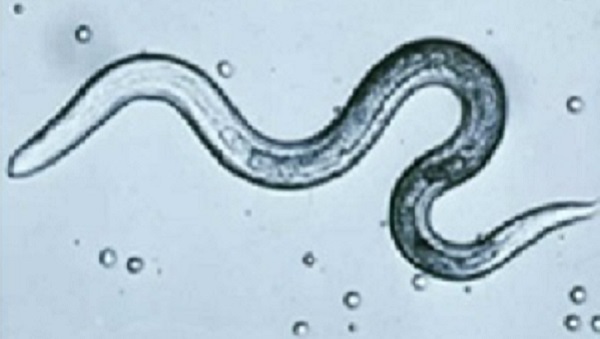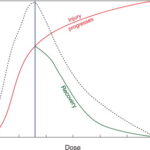Toxocariasis is a parasitic infection caused by the larvae of Toxocara species, primarily Toxocara canis (from dogs) and Toxocara cati (from cats). It is a zoonotic disease that affects humans when infective eggs are accidentally ingested. Although often asymptomatic, the condition can lead to significant complications in certain individuals, particularly children and those with compromised immune systems.

Transmission and Risk Factors
Humans contract toxocariasis primarily through the accidental ingestion of embryonated Toxocara eggs. Common sources include:
- Contaminated soil or sandboxes
- Unwashed vegetables or fruits
- Contact with infected pets
- Poor hygiene practices
Children aged 1–6 years are especially vulnerable due to frequent soil contact and hand-to-mouth behavior.
Clinical Forms of Toxocariasis
Toxocariasis presents in different clinical syndromes, depending on the organ systems involved:
Visceral Larva Migrans (VLM)
This systemic form results from larval migration through internal organs such as the liver, lungs, and brain.
Symptoms include:
- Fever
- Hepatomegaly
- Wheezing and coughing
- Abdominal pain
- Fatigue
- Eosinophilia
Ocular Larva Migrans (OLM)
OLM occurs when larvae migrate to the eye, leading to serious ophthalmologic consequences.
Symptoms include:
- Vision loss
- Strabismus (crossed eyes)
- Retinal granuloma
- Retinal detachment
Neurotoxocariasis
This rare but severe form involves the central nervous system.
Symptoms may involve:
- Seizures
- Meningitis
- Cognitive disturbances
- Motor deficits
Diagnosis of Toxocariasis
The diagnosis of toxocariasis is clinical and laboratory-based:
Laboratory Testing
- Enzyme-linked immunosorbent assay (ELISA): The gold standard for detecting Toxocara-specific antibodies.
- Eosinophil count: Elevated eosinophils in blood often support a diagnosis of VLM.
- Liver function tests (LFTs): May show abnormalities in systemic cases.
Imaging Studies
- Ultrasound or CT scan: To detect hepatic or pulmonary lesions.
- Ocular imaging: Fundoscopy and retinal scans for OLM diagnosis.
- MRI or CT of the brain: In suspected neurotoxocariasis cases.
Treatment of Toxocariasis
Treatment depends on the clinical presentation and severity:
Antiparasitic Therapy
- Albendazole: 400 mg twice daily for 5–7 days (first-line treatment)
- Mebendazole: 100–200 mg twice daily for 5–7 days
Adjunctive Therapies
- Corticosteroids: To reduce inflammation, particularly in OLM or severe VLM
- Surgical intervention: In rare ocular cases with retinal detachment or granulomas
Complications and Prognosis
If left untreated, toxocariasis can result in serious and sometimes irreversible complications:
- Permanent vision loss (OLM)
- Pulmonary fibrosis
- Neurologic sequelae
- Chronic hepatic granulomas
However, with early detection and treatment, the prognosis is generally favorable.
Prevention Strategies
Effective prevention of toxocariasis centers around hygiene, animal care, and environmental control:
Pet Management
- Deworm dogs and cats regularly
- Prevent pets from defecating in public or play areas
Environmental Measures
- Cover sandboxes when not in use
- Maintain clean yards and playgrounds
- Dispose of pet feces promptly
Personal Hygiene
- Wash hands thoroughly after outdoor play
- Rinse fruits and vegetables before consumption
- Educate children on safe play habits
Global Prevalence and Public Health Impact
Toxocariasis is globally distributed, particularly in areas with high stray dog and cat populations and inadequate sanitation. Studies indicate:
- Seroprevalence rates in some developing countries exceed 50%
- Children from low-income backgrounds are disproportionately affected
- The CDC classifies toxocariasis as a neglected parasitic infection in the United States due to its underdiagnosed and underreported nature
Toxocariasis remains a significant yet preventable public health issue worldwide. Understanding its etiology, clinical manifestations, diagnostic methods, and prevention strategies is essential in reducing the burden of this parasitic disease. Routine deworming, proper hygiene, and public awareness are the cornerstones of toxocariasis control.
Frequently Asked Questions
What causes toxocariasis in humans?
Toxocariasis is caused by the larvae of Toxocara canis or Toxocara cati, typically transmitted through ingestion of contaminated soil, food, or contact with infected pets.
Is toxocariasis contagious?
No, toxocariasis is not spread person-to-person. It requires ingestion of eggs from contaminated sources.
Can toxocariasis be cured?
Yes, antiparasitic medications such as albendazole or mebendazole are effective. Early treatment prevents complications.
How can I protect my children from toxocariasis?
Practice good hygiene, ensure pets are dewormed regularly, and prevent children from playing in potentially contaminated areas like uncovered sandboxes.
Is toxocariasis dangerous?
While often mild or asymptomatic, toxocariasis can cause severe complications such as vision loss or neurological issues in some individuals. Early diagnosis and treatment are critical.

